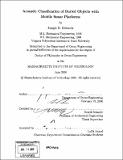Acoustic classification of buried objects with mobile sonar platforms
Author(s)
Edwards, Joseph Richard, 1971-
DownloadFull printable version (162.6Mb)
Other Contributors
Massachusetts Institute of Technology. Dept. of MEchanical Engineering.
Advisor
Henrik Schmidt.
Terms of use
Metadata
Show full item recordAbstract
In this thesis, the use of highly mobile sonar platforms is investigated for the purpose of acoustically classifying compact objects on or below the seabed. The extension of existing strategies, including synthetic aperture sonar and conventional imaging, are explored within the context of the buried object problem. In particular, the need to employ low frequencies for seabed penetration is shown to have a significant impact both due to the relative length of the characteristic scattering mechanisms and due to the interface effects on the target scattering. New sonar strategies are also shown that exploit incoherent wide apertures that are created by multiple sonar platforms. For example, target shape can be inverted by mapping the scattered field from the target with a team of receiver vehicles. A single sonar-adaptive sonar platform is shown to have the ability to perform hunting and classification tasks more efficiently than its pre-programmed counterpart. While the monostatic sonar platform is often dominated by the source component, the bistatic or passive receiver platform behavior is controlled by the target response. The sonar-adaptive platform trajectory, however, can result in the platform finishing its classification effort out of position to complete further tasks. (cont.) Within the context of a larger mission, the use of predetermined adaptive behaviors is shown to provide improved detection and classification performance while minimizing the risk to the overall mission. Finally, it is shown that multiple sonar-adaptive platforms can be used to create new sonar strategies for hunting and classifying objects by shape and content. The ability to sample the scattered field from the target across a wide variety of positions allows an analysis of the aspect-dependent behavior of the target. The aspect-dependence of the specular returns indicate the shape of the target, while the secondary returns from an elastic target are also strongly aspect-dependent. These features are exploited for improved classification performance in the buried object hunting mission.
Description
Thesis (Ph. D. in Ocean Engineering)--Massachusetts Institute of Technology, Dept. of Mechanical Engineering, 2006. Includes bibliographical references (p. 229-237).
Date issued
2006Department
Massachusetts Institute of Technology. Department of Mechanical EngineeringPublisher
Massachusetts Institute of Technology
Keywords
MEchanical Engineering.